For the past few years, working on the Bank of North America collection, the Conservation team has been privileged to encounter many interesting and beautiful watermarks, each possessing a hidden history of this centuries old paper. Thus, I would like to share some of the images and information of the watermarks from the BNA collection. The most obvious thing that I learned from my short research about old watermarks is that they are not always identifiable by their appearance.
Watermarks are the seal or trademark of the manufacturers, and also a security measure to prevent counterfeit of important documents such as bank notes, currency, passports and other government documents. Not every sheet of paper was watermarked because only medium or fine quality writing or printing papers were made using a watermarked mould.
Watermarks are impressions of patterns or designs that can be seen when the paper is held up to the light. The patterns have been made of wire and then fastened to the surface of the mould with thinner wire. The images below show how the wire of the signature was attached to the mould. During the paper making process, the pulp fills the mould and is displaced by the wire, resulting in the design being thinner than the rest of the sheet and thus more transparent under the light.
This illustration of the watermark of William Rittenhouse (recorded as the first person who made paper in America as early as 1690), shows how the signature was formed and fastened to the mould’s surface.
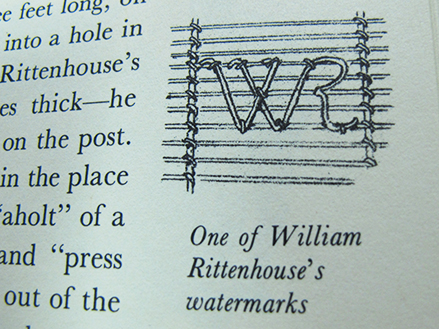
The illustration below shows the structure of the mould where the wire of the patterns would be attached
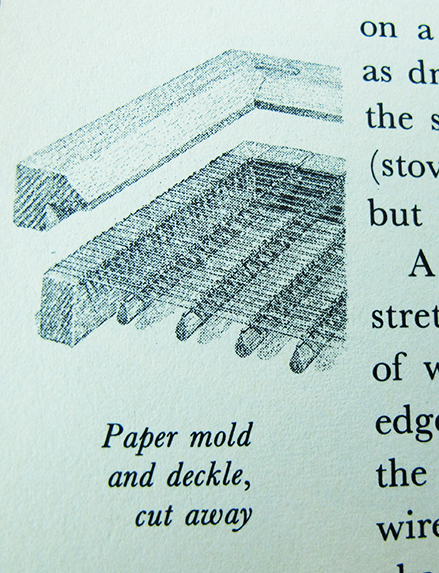
(Both illustrations from Colonial Craftsmen and the Beginning of American Industry, 1965 by Edwin Tunis)
This watermark "B" from the BNA collection (image below) is a great example of how the wire was attached to the mould because the impression of the thin wire is also visible.
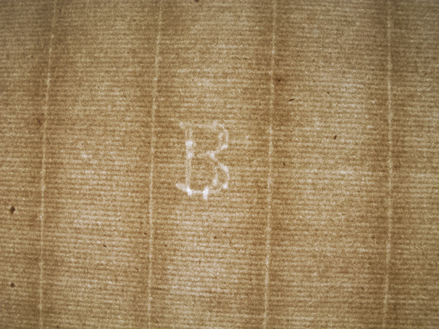
According to Pennsylvania Colonial Paper Mills and Watermarks by James F. Magee, Jr. May 1935, the first known watermarks were used in Bologna in 1282. The early emblems he found in old documents in Philadelphia were mostly of a religious character. Later the watermark became a trademark containing the initials or names of the mill or the papermakers. The first American-made watermarks were mostly the trademarks of the manufacturers of the paper.
The watermarks that we have found in the Bank of North America Collection mostly indicate the manufacturers. Through my research, I believe more than half of the paper was made in the mills in America while some was assumed to be imported from England due to the similarity of the watermarks. The watermark is the signature of the papermaker, but it is not always certain that the paper was made by the papermaker indicated by the watermark.
Sometimes watermarks could be forged, but slight difference could also be the result of the wire being bent or misshapen with use – so it can be incredibly difficult to tell whether a paper was authentic.
In the Catalogue of American Watermarks 1690 – 1835, Thomas L. Gravell and George Miller write that "moulds were expensive and they were often purchased second-hand. Both before and after the Revolution, many paper moulds were bought from English suppliers. These imported moulds were often used without removing the English watermarks. Frequently this was intentional because foreign-made paper was considered to be of better quality than domestically-made paper and often fetched higher prices."
Also, forgery of more valued watermarks was known to have happened in Europe and possibly in America and it made it impossible to identify several watermarks in the BNA collection. And I also found out that papers from different mills from different time periods could have been used to complete one single bound book. So while I was going through some of the watermarks in the BNA collection, I found several that cannot be identified by just comparing with the other pages.
In this blog post, I am going to share some of the watermarks that indicate English papermakers or paper mills, although it is possible that some of these papers were made in America using an imitation or forgery of the English watermark designs.
The watermarks "WELGAR"and "Shield and Fleur-de-lis" found in the vol. 393 were assumed to belong to the mill of William Elgar. Similar images of watermarks found on the website of the National Gallery of Victoria in Australia, explain that “William Elgar operated Chafford Mill on the Medway, outside the village of Fordcombe, near Tonbridge, between c. 1785 and 1802. The mill specialized in the production of fine writing paper, well suited to drawing and watercolor work, used by both [William] Blake and J. M. W. Turner (Peter Bower, ‘The vivid surface: Blake’s use of paper and board’, in Joyce Townsend [ed.], William Blake: The Painter at Work, Tate Publishing, London, 2003, p. 59)." However, there is a very subtle difference in the shape of the shield, between the papers and the ones in the BNA collection. Can we assume that the Elgar papermakers had used different moulds and they are the same paper that Blake and Turner used? Or do we have to consider that they were forgeries made by someone else outside of England?
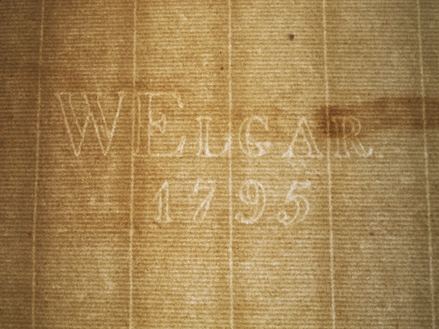

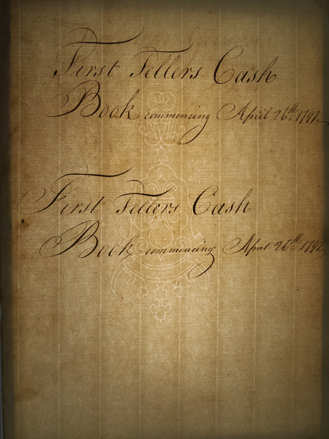
This watermark below obviously says 'JWhatman', the signature of James Whatman I & II, Turkey Mill in Maidstone, Kent, England. The Whatman paper was known as one of the finest English papers of the 1700s and by the mid-century it was one of the largest paper suppliers in Europe. However this watermark I found in the BNA collection is not Whatman's:
"A genuine Whatman watermark does not have a crossed section in the centre of the letter 'W'. Numerous forgeries of the Whatman watermark are known, displaying varying differences, some subtle and others more obvious. Paper analysis by Peter Bower, who has written extensively on the subject, shows that Whatman watermarks were forged in France, Germany and Austria." - Conservation/ National Gallery of Australia.
Finding out this information was both disappointing and exciting at the same time. It was not the famouse Whatman paper but it was the evidence of the complex history of handmade paper and the business around it.
Then, should the 'Strasboug Bend' watermark (image below of the 'JWhatman') also be considered as a forgery?
More information about James Whatman and similar images can be found at National Gallery of Australia and New York Public Library. Also drawn images of genuine Whatman watermarks and some examples of forgery can be seen at BAPH ( British Association of Paper Historians).
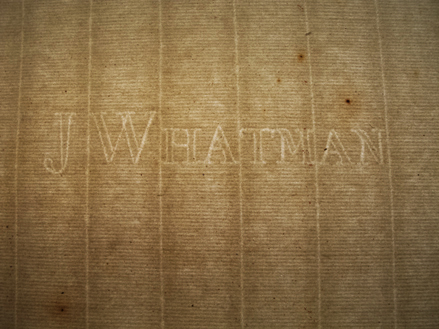 .
.
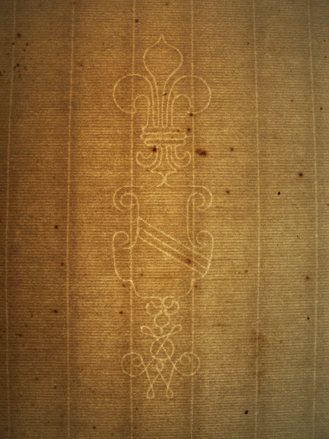
(found in BNA collection that looks almost same as the Whatman 'Strasbourg Bend' watermark, with the JW cypher beneath the bottom pendant)
This image of half of the watermark 'A BLACKWELL' is assumed to be a trademark of Ann Blackwell of Nash Mill, in Hemel Hempstead, Herfordshire, UK.
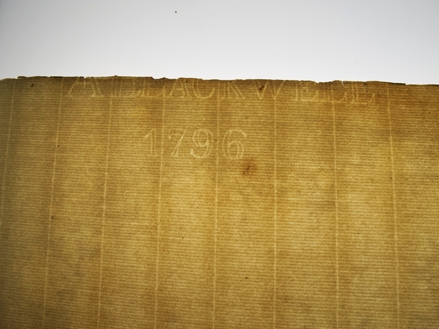
The initial below probably means Clement Taylor(c.1745-1804), a famous British papermaker of Tovil Place, Maidstone, Kent, UK. More information about him can be found here.
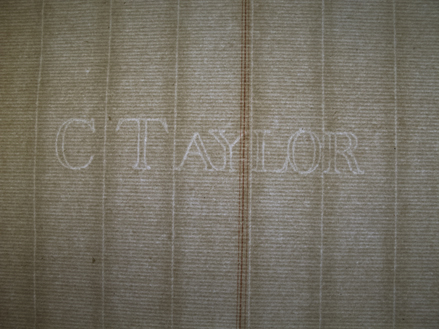
There are two very interesting but unidentified watermarks, 'Lay Jun' and 'C Patch' that I would like to find out more about. They could indicate papermakers either in Europe or America. If anyone can recognize these two unidentified watermarks, and wishes to share their knowledge or information about them, please contribute in the comments section below.

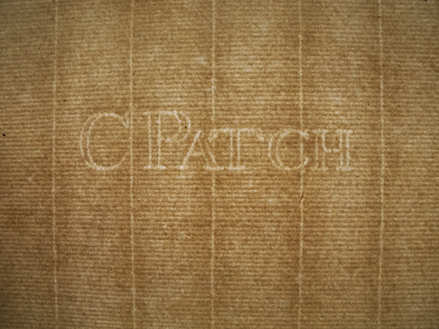
In a few months I will write a second blog post about the watermarks in the BNA collection, since I would like to share the watermarks of American mills and manufacturers and their brief history.

